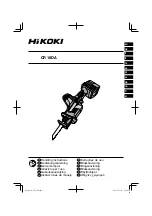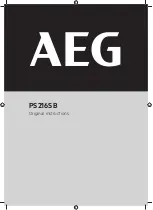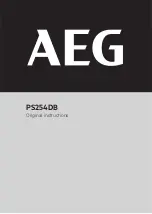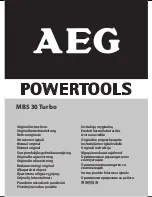
Page 12 — English
OPERATION
MOUNTING HOLES
See Figure 3, page 17.
The saw can be mounted to a firm supporting surface such
as a workbench or mounting boards, if desired. The saw base
has four mounting holes for this purpose. Trace mounting
holes onto mounting surface as shown. Secure using bolts
and washers (not included). Bolts should be of sufficient length
to accommodate the saw base, washers, and the thickness
of the workbench or mounting board. Tighten bolts securely.
Carefully check the workbench after mounting to make sure
that no movement can occur during use. If any tipping, slid-
ing, or walking is noted, secure the workbench to the floor
before operating.
WORK CLAMP
See Figure 4, page 17.
WARNING:
In some operations, the work clamp assembly may
interfere with the operation of the blade guard assembly.
Always make sure there is no interference with the blade
guard prior to beginning any cutting operation to reduce
the risk of serious personal injury.
The work clamp provides greater control by clamping the
workpiece to the fence or the saw table. It also prevents
the workpiece from creeping toward the saw blade. This is
very helpful when cutting miters. Depending on the cutting
operation and the size of the workpiece, it may be neces-
sary to use a C-clamp or other suitable clamp instead of the
work clamp to secure the workpiece prior to making the cut.
To install the work clamp:
Remove the battery pack.
Align the work clamp shaft in the corresponding hole lo-
cated at the end of the saw table. Clamp will only install
in one position.
Rotate the work clamp knob to move it up or down as
needed to secure the workpiece.
To use the work clamp:
With fence mounted to the flooring saw (see instructions
below), place the workpiece firmly against the fence.
Rotate the knob on the work clamp to move the clamp
up or down as needed. Do not overtighten.
Use the adjusting knob to adjust the length or rotation of
the clamp.
TO INSTALL FENCE FOR MAKING MITER /
CROSS CUTS
See Figures 5 - 6, page 17.
Remove the battery pack.
Remove fence lock knob from slide rail.
Install fence.
Place the fence lock knob into the miter groove and the
locator pin (under center of fence) in the anchor hole.
Slide the adjusting clamp along the miter groove until
reaching the desired angle.
Insert the work clamp through the hole in the miter
fence and into the hole on the table. Do not tighten
clamp knob.
Tighten the fence lock knob to secure the miter fence.
Tighten the clamp knob securely to the work piece.
TO INSTALL FENCE FOR MAKING RIP CUTS
See Figure 7, page 18.
Remove the battery pack.
Remove fence lock knob and washer from slide rail.
With the fence parallel to the saw table, place the locator
pins in the right groove of the saw table and the left side
of the fence in the left groove of the saw table.
Slide the adjusting clamp along the rip groove until reach-
ing the desired distance for the cut.
Place the fence lock knob into the corresponding hole of
the saw table.
Using the scales on the saw table, check that both the
left and right sides of the fence are the same distance
from the blade so the fence is squared to the blade.
Tighten the fence lock knob and washer to secure the
miter fence.
Tighten the clamp knob securely to the work piece.
TO USE THE DUST BAG
See Figure 8, page 18.
Remove the battery pack.
Slide dust bag onto dust exhaust port.
WARNING:
Collected dust from surface coatings such as polyure-
thanes, linseed oil, etc., can self-ignite in the dust bag or
elsewhere and cause fire. To reduce the risk of fire, always
empty the dust bag frequently (10-15 minutes) and never
store or leave the tool without totally emptying its dust
bag. Also follow the recommendations of the coatings
manufacturers.
TO USE WITH A SHOP VACUUM OR DUST
COLLECTION SYSTEM
You can easily attach a shop vacuum or dust collection
system to the saw.
To attach:
Remove the battery pack.
Remove dust bag from saw.
Attach vacuum hose to dust exhaust port.
Содержание PGC21B
Страница 58: ...NOTES NOTAS...
Страница 59: ...NOTES NOTAS...













































